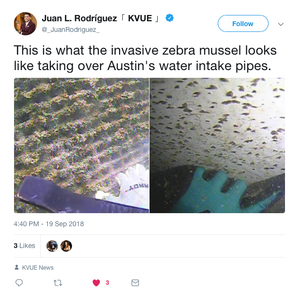 |
September 2018
|
 |
 |
Registration Open for Texas Invasive Plant and Pest Conference!
Register for the 7th Texas Invasive Plant and Pest Conference, to be held at the Univeristy of Texas at Austin Lady Bird Johnson Wildflower Center. The early-bird deadline is past and the registration fee is now $200 for non-students and $85 for students. Abstract submission is also closed.
NOTE: due to technical issues, it is possible that your abstract did not get submitted. Please check the list of abstracts to see if your astract is listed. If not, please contact Hans Landel as soon as possible.
Four field trips and a workshop are scheduled. One field trip will tour the Lady Bird Johnson Wildflower Center's research plots, one will explore the city of Austin's invasives management, one will explore invasive plant management at the Balcones Canyonlands Preserve (BCP) followed by zebra mussels at Lake Travis, and the final field trip will be a guided tour of the LBJ Presidential Library. Some field trips require an additional fee.
More information on registration, the field trips, and the workshop can be found on the conference website. The schedule will be posted there soon.
Register today!
|
 |

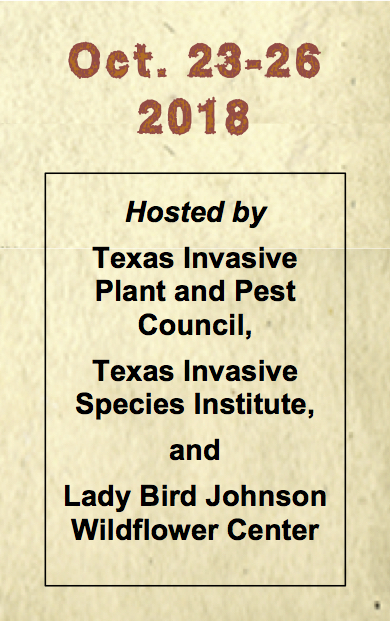
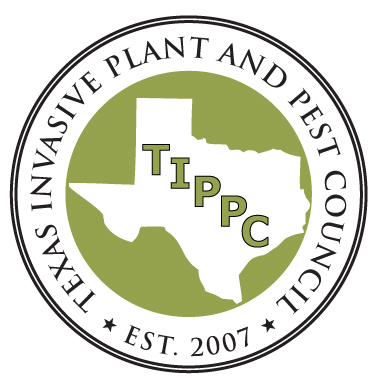
|
 |
 |
Once the Darling of Landscapers, Bradford Pear Is Now an Ecological Nightmare
In a very informative article, Adrian Higgins of The Washington Post describes the history of the callery pear (Pyrus calleryana) and its derivative, the Bradford pear, in the United States. What began as a search for a pear that was resistant to a disease devastating the pear industry, became one of the most successful horticultural introductions in the United States and, ultimately, an example of how a plant can become ecologically devastating itself.
In the early 1900s, plant scientist Frank Reimer found that the callery pear, which is native to China, was resistant to fire blight, a disease caused by the bacterium Erwinia amylovora. Because the callery pear produces tiny fruit, he decided to use it as rootstock onto which the production pears could be grafted. Needing more plants for his research, eventually he worked with an explorer named Frank Meyer, who traveled to China to collect seeds of the callery pear. There, Meyer found it had the ability to grow in a variety of conditions – a harbinger of its potential invasive characteristics. (Meyer is remembered for the lemon tree he discovered that in his honor carries his name.)
Eventually, in the 1950s and 1960s, a variety of the callery pear, the Bradford pear, was discovered that had qualities that made it the darling of the horticulture industry. It was planted by the millions across the country. It was even promoted by the United States National Arboretum. However, its beauty, disease resistance, and apparent sterility belied its ability to become fertile and spread into the countryside. It is now replacing native plants, forming thickets of trees with three-inch thorns and impacting ecosystem function. Across the United States, managers of parks and other natural areas spend untold amounts of time and resources trying to control it – even while it is still for sale in many areas of the country.
|
 |

Credit: Leslie J. Mehrhoff, University of Connecticut, Bugwood.org

Credit: Leslie J. Mehrhoff, University of Connecticut, Bugwood.org
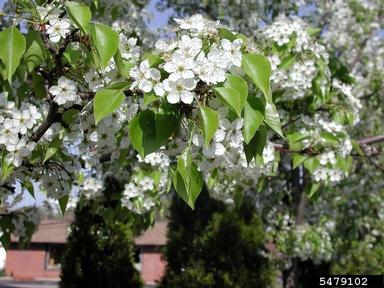
Credit: Leslie J. Mehrhoff, University of Connecticut, Bugwood.org
|
 |
Invasive Spotlight:
Redbay Ambrosia Beetle
(Xyleborus glabratus)
The redbay ambrosia beetle (RAB) is a dark colored, bullet shaped beetle with small puncture-like dents covering the elytra, and is 2 mm long when mature. RAB can be identified with a characteristic snout representing modified mandibles for taking up nutrients. Positive identification of X. glabratus is almost impossible without the help of a professional, but the glaborous upper surface and abrupt apical declivity may help distinguish this invasive beetle from other native species. RAB larvae are legless, white grubs with amber colored head capsules. These flightless grubs are found feeding on infected trees beneath or on the surface of the bark.
Originally from India, Japan, Myanmar, and Taiwan, RAB is a known vector of the vascular fungus Raffaelea lauricola, which causes the host plant to wilt and die within a matter of months or even weeks. In fact, the female beetle has a special organ she uses to carry the fungus, which she innoculates in the tree. The larvae actually feed on the fungus and not the tree iteslf. This insect-disease complex is referred to as laurel wilt in the literature. Flight allows the beetle to transfer the fungus to new hosts rapidly.
In 2002 RAB was discovered near Port Wentworth, Georgia by chance in a survey trap. Within three years the beetle spread through the southeast U.S. and was associated with death to ambrosia and sassafras trees in Florida. Experts believe introduction of RAB was facilitated by solid wood packing materials such as crates or pallets. Trees in in the family Lauraceae, including redbay, sassafras, pondspice, bay laurel, and avocado are susceptible. Found in AL, AR, FL, GA, LA, MS, NC, SC, and recently in Bowie, Cass, Hardin, Jasper, and Tyler Counties, TX.
Report observations of possible RAB, such as symptomatic host plants, using the “Report It!” function of www.texasinvasives.org and the Texas Invaders mobile app.
Learn more by reading the most current Laurel Wilt synopsis, or view the most recent map to see Laurel wilt’s history of spread. Follow this link to learn more about the redbay ambrosia beetle.
|
 |
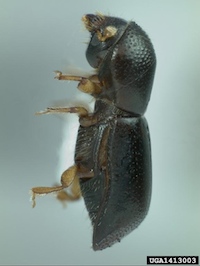
Credit: Michael Thomas, Florida Department of Agriculture and Consumer Services, Bugwood.org

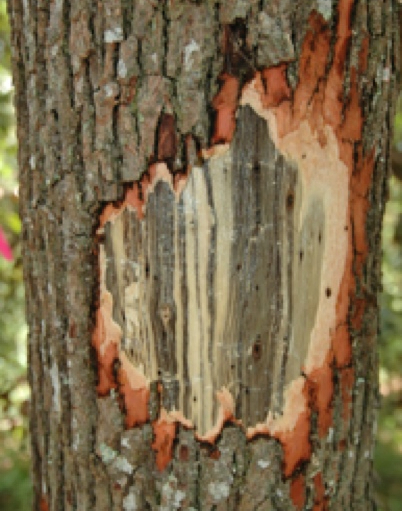
Red foliage and epicormics shoots on red bay (above), coupled with stained sapwood, are characteristic symptoms of infection by laurel wilt.
Photo credit: Ron Billings
|
 |
 |
More News
Migrating Monarchs Facing Increased Parasite Risks
Planting of the non-native tropical milkweed (Asclepias curassavica) has led to non-migratory populations (NMPs) of monarch butterflies (Danaus plexippus). These NMPs tend to have much higher rates of infection with the protozoan parasite, Ophryocystis elektroscirrha. Migrating butterflies found with the NMPs also have higher infection rates that are three times higher compared to those found elsewhere. Learn more at sciencedaily.com.
Virus May Help Combat Fire Ants, But Caution Is Needed
A specific virus changes the dietary behavior of fire ants (Solenopsis invicta), making it less likely that they are counted accurately and that they will eat enough of poisonous baits to be controlled. Read more at sciencedaily.com.
Common Weed Killer Linked to Bee Deaths
Honey bees exposed to glyphosate, the active ingredient in Roundup, lose some of the beneficial bacteria in their guts and are more susceptible to infection and death from harmful bacteria. Scientists believe this is evidence that glyphosate might be contributing to the decline of honey bees and and potentially affect native bees around the world. Read more at sciencedaily.com.
Invasion Risk of Starry Stonewort in Upper Midwest
Researchers recently published a new article predicting the risk of starry stonewort (Nitellopsis obtusa) in Minnesota and Wisconsin lakes. Starry stonewort is a macroagla invasive in North America. See sciencedaily.com for more information.
APHIS Update on Spotted Lanternfly Activities
The Animal and Plant Health Inspection Service (APHIS) has released an update of spotted lanternfly (SLF) (Lycorma delicatula) activities in Pennsylvania, Virginia, New Jersey, and Delaware. SLF feeds on more than 70 types of plants, including crops such as grapes, apples, hops, walnuts, and other hardwood trees. SLF suck sap from stems and leaves, damaging plants as they feed. SLF has the potential to invade Texas, because one of its larval stages appears to require the tree of heaven (Ailanthus altissima), an invasive found in Texas. Learn more at ipmsouth.com, and dontmovefirewood.org.
Remote Islands Harbor Higher Numbers of Non-Native Species
It is well established that the more remote an island is, the fewer native species it supports. Surprisingly, research has found that the opposite is true for non-native species. See sciencedaily.com for more information.
Global Trade in Exotic Pets Threatens Endangered Parrots Through the Spread of a Virus
Beak and feather disease virus (BFDV) in wild parrot populations has been detected in eight new countries, raising concerns for threatened species. This highlights the need for greater awareness of the risks of the spread of infectious disease associated with the international trade in live parrots. Read more at sciencedaily.com.
Scientists Crack Genetic Code of Cane Toad
Scientists have unlocked the DNA of the cane toad (Rhinella marina), a poisonous amphibian that is a threat to many native Australian species. The information has lead to recognizing potential virus control agents. Learn more at sciencedaily.com.
Invasive Pines Fueled 2017 Fires in South Africa
The replacement of natural fynbos vegetation with pine plantations in the southern Cape in South Africa, and the subsequent invasion of surrounding land by invasive pine trees, significantly increased the severity of the 2017 Knysna wildfires, which burned 15000 hectares, claimed the lives of seven people, and destroyed more than 5000 hectares of commercial pine plantations and over 800 buildings. Learn more at sciencedaily.com.
New Invasive Bryozoan Arrives in Alaskan Waters
Alaska has a near-pristine marine ecosystem--it has fewer invasive species in its waters than almost any other state in the U.S. However, reserchers have discovered a new invasive invertebrate filter-feeder, Bugula neritina, and documented the continuing spread of three other non-native species. Learn more at sciencedaily.com.
Florida FWC Announces Winners of Lionfish Challenge
Lionfish (Pterois volitans) is an exotic invasive species that is displacing local fish from waters off of Florida's coast. Hunting competitions have been one of the only ways to curb their spread. A total of 28,260 lionfish were removed from Florida waters as part of this year’s challenge, which included recreational and commercial categories as well as a new tagged-lionfish component, rewarding participants with prizes up to $5,000 for removal of lionfish tagged by the Florida Fish and Wildlife Conservation Commission (FWC). Read more at ipmsouth.com.
APHIS Proposes to Remove the Domestic Quarantine for Emerald Ash Borer
The US Department of Agriculture's Animal and Plant Health Inspection Service (APHIS) is proposing to remove the domestic quarantine regulations for the emerald ash borer (EAB) (Agrilus planipennis). Eliminating this regulation is in keeping with USDA’s goal of reducing regulations that have outlived their usefulness. The proposal would end APHIS’ domestic regulatory activities, such as issuing permits, certificates and compliance agreements, making site visits, and conducting investigations of suspected violations, and instead direct all available resources toward managing the pest. APHIS remains committed to controlling this invasive pest and wants to conduct more research and release a greater number of biological control agents—tiny stingless wasps that are natural predators of the EAB—since biocontrol has shown the most promise for stopping EAB’s spread. The proposed rule is available in the Federal Register and open for comment through November 19, 2018. See ipmsouth.com for more information, including about how to comment on the proposed change.
|
 |
 |
If you would like to highlight a successful invasive species project or nominate a special person to be highlighted in an upcoming iWire, please send the details to iwire@texasinvasives.org.
|
 |
 |
|
|
 |
Sentinel Pest Network and Invaders of Texas Workshops
Invaders of Texas workshops train volunteers to become citizen scientists to detect and report invasive species. Workshops, which are free, include information on the Sentinel Pest Network, which serves to increase the awareness and early detection of the Emerald Ash Borer, Cactus Moth, Asian Longhorned Beetle, and other pests of regulatory significance.
Workshops are tailored to meet the interests of your volunteer group, and supplementary session examples include an introduction to the TX Invaders mobile application and the Eradicator Calculator, a feature on Texasinvasives.org designed to help organize and track volunteer-based eradication efforts.
Upcoming Workshops:
Saturday, October 6, 2018
Location: Houston Advanced Research Center (The Woodlands, TX)
Contact: Teri MacArthur
Friday, October 12, 2018
Location: Mission Branch Library, 3134 Roosevelt Avenue (San Antonio, TX)
Contact: Rachel Cywinski
Sentinel Pest Network Workshop
Wednesday, October 17, 2018
Location: Mission Branch Library, 3134 Roosevelt Avenue (San Antonio, TX)
Contact: Rachel Cywinski
Sentinel Pest Network Workshop
Sunday, October 21, 2018
Location: Mission Branch Library, 3134 Roosevelt Avenue (San Antonio, TX)
Contact: Rachel Cywinski
Friday, November 10, 2018
Location: Encino Branch Library, 2515 Evans Road East (San Antonio, TX)
Contact: Jerry Morrisey
Saturday, January 19, 2019 (registration not open yet)
Location: Library, University of the Incarnate Word (San Antonio, TX)
Contact: Pamela Ball
For more information or to register to attend a free workshop, please visit the Workshop Page. |
 |
 |
|









